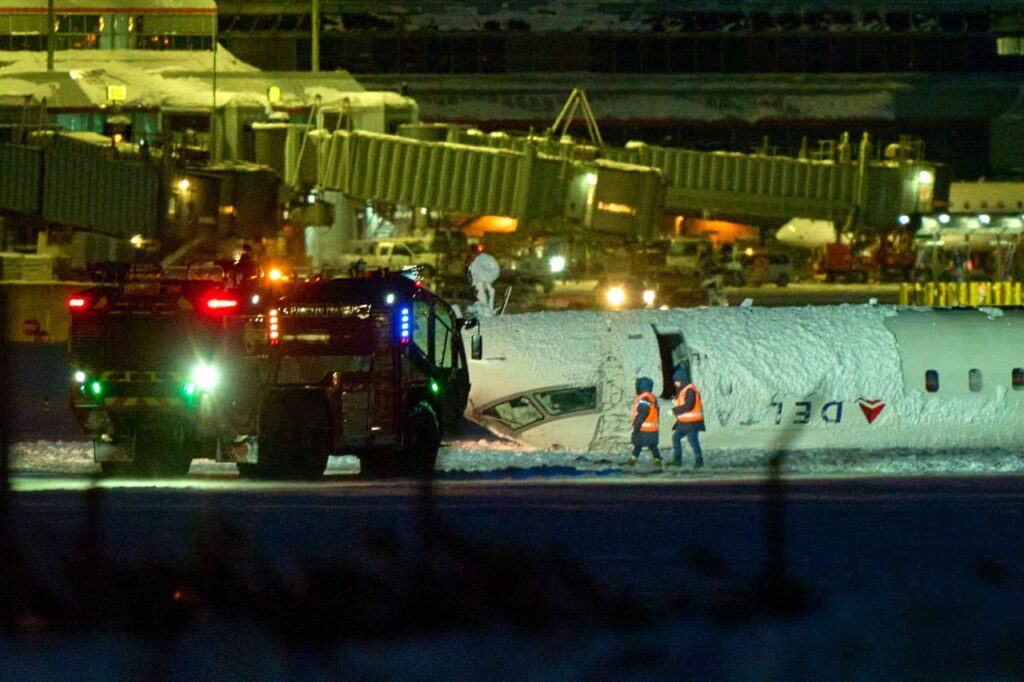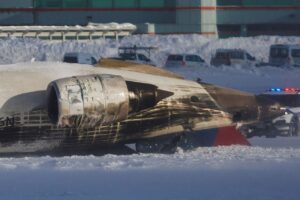On February 17, 2025, Delta Connection Flight 4819, operated by Endeavor Air, tragically crashed upon landing at Toronto Pearson International Airport, flipping upside down. The flight, which had departed from Minneapolis-Saint Paul International Airport, was en route to Toronto with 80 people aboard, including 76 passengers and four crew members.
The incident occurred around 2:15 PM local time, as the Bombardier CRJ900 aircraft made its approach to the airport. After an uneventful journey, the plane’s landing took a disastrous turn, crashing just as it touched down on runway 23. Witnesses reported hearing a loud crash and seeing the aircraft quickly flip upside down, coming to a stop near the intersection of runway 23 and runway 15.
The crash was particularly alarming given the conditions at the airport. A winter storm had recently passed through the region, and there was snow on the runway. In addition, strong winds were recorded at the time, reaching speeds of 32 mph (51 kph) with gusts up to 40 mph (65 kph). These challenging weather conditions, coupled with reports from air traffic controllers warning of air flow bumps in the glide path, might have contributed to the incident.
Miraculous Survival
Remarkably, all 80 passengers and crew members survived the crash, although 18 people sustained injuries. Thankfully, none of the injuries were life-threatening. Among the injured were a child and two adults—one in his 60s and another in her 40s. Three individuals were transported to nearby hospitals by air ambulance for treatment. Incredibly, the vast majority of the passengers, including the flight crew, were able to walk away from the wreckage.
Quick Response from Emergency Services

Toronto Pearson International Airport’s emergency services responded swiftly to the incident. Firefighters and paramedics were on the scene within moments of the crash, quickly evacuating passengers from the overturned plane before it could catch fire. Their prompt action undoubtedly prevented further casualties and minimized the potential for more severe damage.
Investigation Underway
In the wake of the crash, the Transportation Safety Board of Canada (TSB) has launched a full investigation to determine the cause of the incident. The U.S. National Transportation Safety Board (NTSB) has also been called in to assist, given that Delta Air Lines is based in the United States. The investigation will examine multiple factors, including the aircraft’s condition, the weather conditions at the time of landing, and whether any mechanical failures or human error contributed to the crash.
Air traffic controllers had warned the pilots about the possibility of air flow disturbances, but it remains unclear whether this played a significant role in the crash. Preliminary findings will likely be released after a detailed investigation is conducted.
Airport Disruptions and Recovery

In the immediate aftermath of the crash, all departures and arrivals at Toronto Pearson International Airport were temporarily halted. The airport resumed operations later that day, but the disruption underscored the severity of the incident and the challenges posed by extreme weather conditions at airports.
Public Reaction and Safety Concerns
The crash has prompted widespread attention, highlighting both the vulnerability of aviation during challenging weather conditions and the critical importance of safety protocols. The fact that all passengers and crew survived, many with only minor injuries, is a testament to the safety measures in place on modern aircraft, such as reinforced fuselages, well-trained flight crews, and advanced emergency procedures.
For many, however, the incident raises concerns about the safety of air travel during harsh weather. The weather conditions during this incident were challenging, and the fact that the aircraft flipped underscores the unpredictable nature of aviation, particularly during winter months when ice, snow, and winds complicate landing procedures.
Conclusion
As investigations continue, the miraculous survival of the Delta flight’s passengers and crew will be remembered as a close call in the world of aviation. While many questions remain, the incident serves as a reminder of the importance of rigorous safety standards and the critical role of emergency services in responding to such incidents. The hope is that the findings from the ongoing investigation will provide valuable insights to further improve aviation safety and help prevent similar incidents in the future.
The recovery of the passengers and crew and the quick response by airport emergency services exemplify the resilience of both people and systems under pressure.
We will continue to update this story as more details emerge.